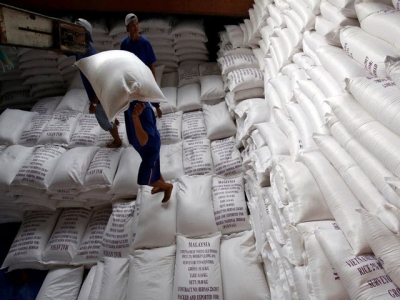Asia Rice-Top hubs see muted activity; fresh supply to weigh on Vietnam rates

Export prices for rice were little changed in major hubs in Asia amid few new deals, with rates for the Vietnamese variety expected to fall further in the coming week as the ongoing harvest picks up pace, boosting domestic stocks.
Men load rice bags to a ship for export at a rice processing factory in Vietnam's southern Mekong delta, Vietnam July 6, 2017. Photo: Reuters
Rates for Vietnam’s 5 percent broken rice were $350 a tonne on Thursday, flat from last week.
“Prices will likely fall further over the coming weeks as the summer-autumn harvest is picking up pace,” a trader based in Ho chi Minh City said, adding the harvest will peak mid-June.
However, the quality of rice from the new harvest is expected to be lower than that of the winter-spring harvest due to adverse weather and crop diseases, another trader said.
The government estimated Vietnam’s rice exports in the January-May period fell 5.3% from a year earlier.
Meanwhile, Bangladesh, traditionally the world’s fourth biggest rice producer, lifted a long-standing ban on exports on Thursday.
Bangladesh aims to sell as much as 1.5 million tonnes, the country’s agriculture minister Abdur Razzak said, in a move aimed at supporting farmers amid a drastic drop in domestic prices.
Last week, Bangladesh raised rice import duty to 55% from 28% amid widespread protests by growers.
Bangladesh had banned all rice exports in 2009. The country now has a surplus of 2-2.5 million tonnes.
Bangladesh’s neighbour and the world’s top rice exporter India saw subdued demand for its benchmark variety from buyers in Africa.
Prices of India’s 5 percent broken rice were unchanged from last week at $364-$367 per tonne.
“Export demand is weak but we couldn’t cut prices due to the rising rupee,” Ashwin Shah, director at Shah Nanji Nagsi Exports Pvt. Ltd, an exporter based in Nagpur in central India.
A strong rupee reduces exporters’ margin from overseas sales.
Thailand’s benchmark 5-percent broken rice prices were largely unchanged at $385-$402 a tonne on Thursday, free on board Bangkok (FOB), from $385-$400 last week, as it faces stiff competition from other exporters.
There are no major deals in sight, traders said, attributing slight moves in prices to currency fluctuations.
“Prices could not go up because other exporters sell rice cheaper than ours, and the price could not go down because the baht is too strong,” a Bangkok-based rice trader said.
The Thai Commerce Ministry projected the country’s rice exports at 10 million tonnes this year, versus last year’s 11 million tonnes, while the Rice Exporters Association pegged 2019 exports at 9.5 million tonnes.
Có thể bạn quan tâm
 Ethnic minority youth lead start-up wave with traditional products
Ethnic minority youth lead start-up wave with traditional products In his late 20s, Hồ Văn Thằng decided to launch his first business growing the species of chili pepper his family has treasured for centuries on the western
 Cotton gains ground with up-to-date harvesting tech
Cotton gains ground with up-to-date harvesting tech Deon Marais tries to spend at least a few weeks every year out in the field bringing in the cotton crop. Having grown up in the industry
 Fruit, vegetable exports top 1.6 billion USD
Fruit, vegetable exports top 1.6 billion USD Export turnover of fruits and vegetables has exceeded 1.6 billion USD since the beginning of 2019, a year-on-year rise of 8.9 percent.